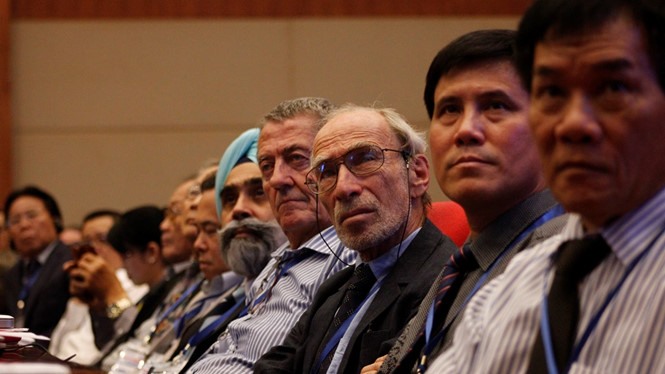 Environment
Environment

International scholars called on all East Sea (South China Sea) claimants, especially China, to collaborate in addressing massive coral reef destruction that might lead to economic losses of up to US$5.6 billion a year.
 |
| nternational scholars called on all East Sea (South China Sea) claimants, especially China, to collaborate in addressing massive coral reef destruction that might lead to economic losses of up to US$5.6 billion a year. — Photo thanhnien.vn |
HẢI PHÒNG – International scholars called on all East Sea (South China Sea) claimants, especially China, to collaborate in addressing massive coral reef destruction that might lead to economic losses of up to US$5.6 billion a year.
Satellite images indicated that more than 16sq km of offshore reefs in the East Sea had been damaged by human activities, of which China was proportionately responsible for nearly 99 per cent of the destruction, Professor John McManus from the University of Miami said at a two-day international scientific seminar on environmental and maritime security held in Hải Phòng City yesterday.
Beijing was blamed for the disappearance of 15.9sq km of coral reefs, due to its giant clam overexploitation, the construction of artificial islands, and dredging activities.
“The Chinese Government claimed that they only built artificial islands on dead coral. Basically, they didn’t lie,” said McManus.
“However, it all started when they (China) dug up the reefs for giant clams and killed all the coral reefs (before building the islands). It happened in every single case of building artificial islands”.
The historic arbitral ruling in July between the Philippines and China, besides smashing Beijing’s unilateral so-called ‘nine-dash line’, called out the Asian powerhouse for turning a blind eye to Chinese fishermen harvesting giant clams “on a substantial scale in the South China Sea” by using methods that inflict “severe damage to the coral reef environment”.
The ruling also criticised China over the large-scale land reclamation that caused “irreparable harm to the marine environment”. Professor McManus believed that the artificial island construction and dredging essentially damaged about 17sq km of offshore reefs, permanently.
A paper published in 2012 by ecologist Rudolf de Groot at Wageningen University and Research Centre estimated that a hectare of coral reef was valued at approximately $350,000 a year.
With the current coral damage in the East Sea, the potential economic losses could shoot up to $5.6 billion a year.
“The number was based on the visible coral losses in shallow water. We still don’t know the coral reefs damaged in deep water,” said Annette Juinio-Menez from the University of the Philippines’ Marine Science Institute.
Coral reefs in the disputed East Sea, particularly those in the Spratly (Trường Sa) Islands, were the hosting areas for one of the most productive and diverse marine environments in the world.
While the East Sea faces the serious threat of marine degradation due to the disappearance of coral reefs en masse, overfishing poses a further risk to 3.4 million people directly dependent on fisheries for a living, in Việt Nam, the Philippines, Taiwan and the south of mainland China.
“Fisheries in the South China Sea are already near the scramble point for everyone to catch fish,” McManus said, warning about a fishery collapse in the near future if overfishing continues.
“China last year said it would cut fishing in the South China Sea by three per cent, yet it is just a small point. We need to reduce by at least 30 or 40 per cent,” he said.
Marine protection mechanisms
Scholars supported the idea of establishing unilateral or multilateral marine protected areas (MPAs) in specific zones of the East Sea to maintain environmental security.
Việt Nam earlier approved setting up a MPA around Nam Yết (Namyit) Island, and was considering another one in the Barque Canada Reef – both of them encompassing extraordinary biodiversity, according to Nha Trang Institute of Oceanography head Võ Sĩ Tuấn.
The Philippines was also planning a MPA in the southern part of the Trường Sa archipelago, yet there were no signs of a multilateral MPA in the region.
Professor McManus proposed a Peace Park in Trường Sa, in which all member countries at first had to agree on freezing all of their territorial claims and activities to support such claims before co-operating to tackle the environmental issues.
“The biggest challenge is convincing China to support such mechanisms. China has agreed that we must stop the fishery collapse, the environmental damage and they know they must try to stop it,” he said.
“It’s just that China is not clear of how it should do so”. – VNS




